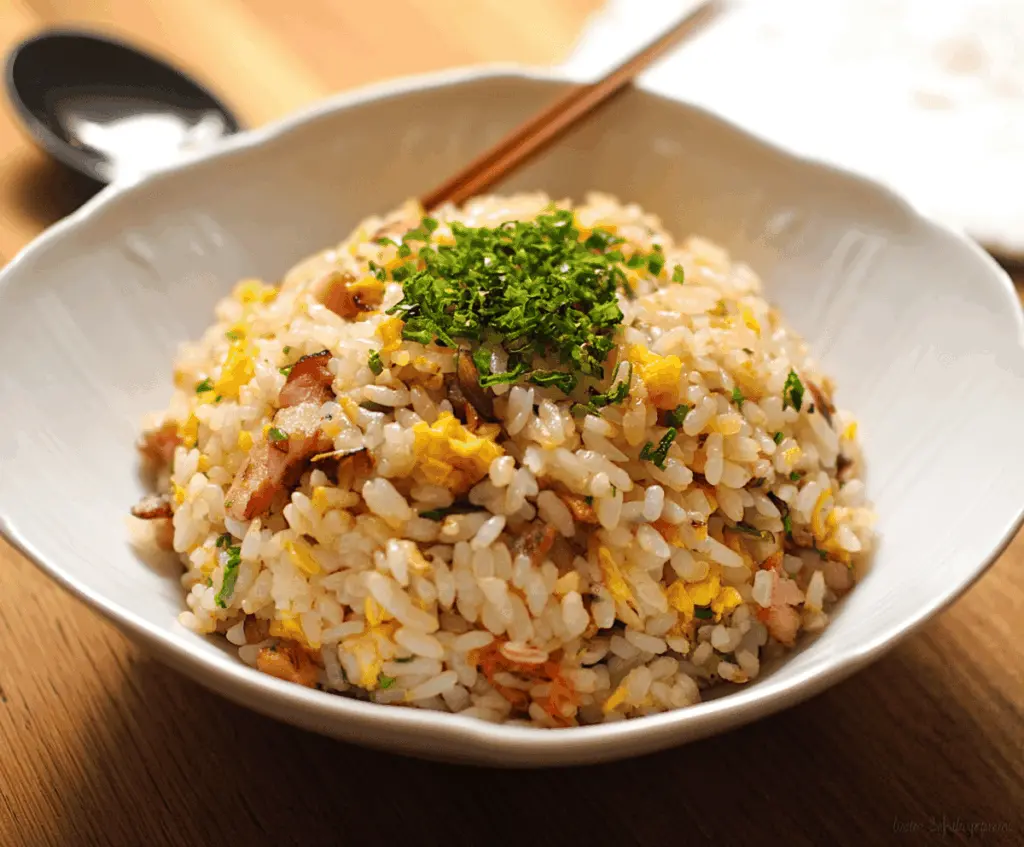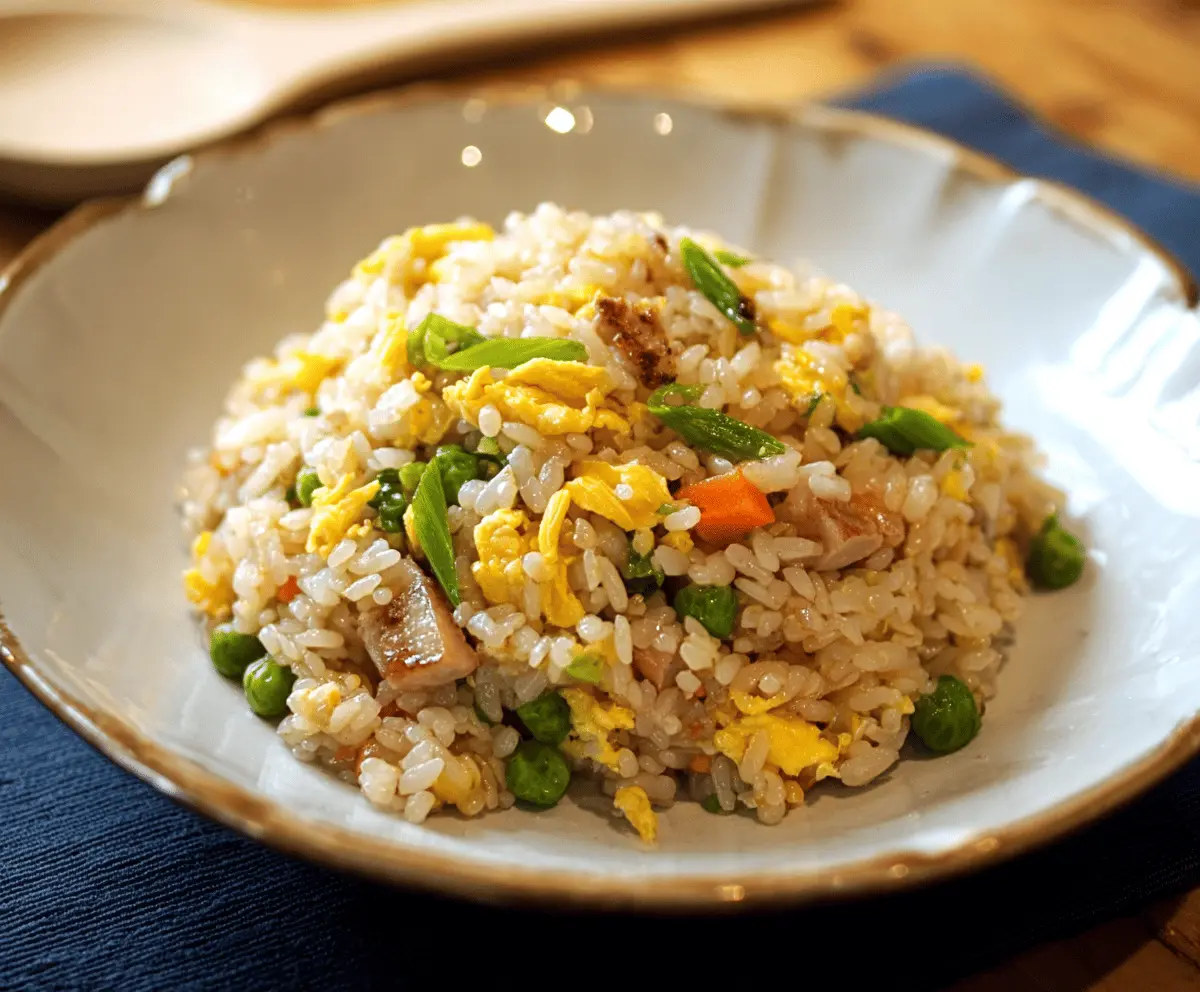
Japanese Fried Rice
Japanese Fried Rice is a simple and tasty dish that's perfect for using up leftover rice and adding a bit of flavor with ingredients like eggs, green onions, and soy…
Tip: save now, cook later.Japanese Fried Rice is a simple and tasty dish that’s perfect for using up leftover rice and adding a bit of flavor with ingredients like eggs, green onions, and soy sauce. It’s quick to make and has a nice balance of savory and slightly sweet notes that make it really satisfying.
I love making this fried rice when I’m in a hurry but still want something warm and filling. One of my favorite tricks is to use day-old rice because it fries up better and doesn’t get mushy. Plus, tossing in a bit of butter or sesame oil gives it a subtle richness that makes every bite better.
Whenever I serve Japanese Fried Rice at home, I like to sprinkle some toasted sesame seeds or chopped green onions on top. It adds a little crunch and freshness that I think really brightens up the dish. This meal is always a hit, especially when paired with a simple miso soup or some pickled veggies on the side.
Key Ingredients & Substitutions
Japanese short-grain rice: This rice is sticky and perfect for fried rice because it holds together but doesn’t get mushy. Day-old rice works best, but if you don’t have it, spread freshly cooked rice on a tray to cool quickly.
Char siu pork or ham: Char siu adds sweetness and a smoky flavor, but you can swap it for bacon, cooked chicken, or tofu for a vegetarian option. Just make sure it’s diced small for even cooking.
Eggs: They add richness and texture. Lightly scramble them to avoid overcooking. For a dairy-free version, simply omit or replace with scrambled tofu.
Soy sauce and sesame oil: Soy sauce brings umami, while sesame oil adds a fragrant note at the end. Use low-sodium soy sauce if you’re watching salt intake or a gluten-free tamari instead.
Green onions: These add freshness and crunch. If unavailable, finely chopped chives or mild onions work well too.
How Do I Get Perfectly Fluffy Fried Rice Without It Getting Mushy?
The secret to fluffy fried rice is starting with properly cooked and cooled rice. Here’s how to nail it:
- Use rice that is cooked al dente – a little firmer than usual.
- Let the rice cool completely, ideally refrigerated overnight to dry it out slightly.
- Before frying, gently break up any clumps with your fingers or a fork.
- During cooking, use medium-high heat and don’t overcrowd the pan – cook in batches if needed.
- Constantly stir and toss the rice to evenly heat without squashing the grains.
These steps help keep the rice grains separate and give you that light, fluffy texture that’s signature to good fried rice.
Equipment You’ll Need
- Large non-stick frying pan or wok – perfect for cooking the rice evenly and allows easy stirring without sticking.
- Spatula or wooden spoon – helps you toss and break up the rice gently without squashing grains.
- Mixing bowl – to beat the eggs before cooking.
- Measuring spoons – for adding soy sauce and sesame oil accurately.
Flavor Variations & Add-Ins
- Swap char siu pork with diced cooked chicken or shrimp for a different protein option that works well with this dish.
- Stir in finely chopped mushrooms or peas for extra veggies and color.
- Add a bit of grated ginger or minced garlic during cooking to boost flavor and aroma.
- Top with sesame seeds or furikake seasoning for a crunchy texture and extra umami.
Japanese Fried Rice (Chahan) Recipe Guide
Ingredients You’ll Need:
Main Ingredients:
- 3 cups cooked Japanese short-grain rice (preferably day-old)
- 2 large eggs
- 100g (3.5 oz) char siu pork or cooked ham, diced
- 2 tablespoons vegetable oil (or canola oil)
- 2 green onions, finely sliced (reserve some for garnish)
- 1 tablespoon soy sauce
- 1 teaspoon sesame oil
- Salt and pepper, to taste
- Optional: finely chopped pickled ginger or peas for extra flavor
Time You’ll Need:
This recipe takes about 10 minutes of preparation and 10 minutes to cook. If using freshly cooked rice, allow extra time to cool the rice properly for best results. Overall, plan for around 20-25 minutes for the entire process.
Step-by-Step Instructions:
1. Prepare the Rice and Eggs:
If you haven’t already, prepare your rice and refrigerate it overnight for the best texture. If the rice is freshly cooked, cool it thoroughly before use. Beat the eggs lightly with a pinch of salt.
2. Cook the Eggs:
Heat 1 tablespoon of vegetable oil in a large frying pan or wok over medium-high heat. Pour in the beaten eggs and lightly scramble until just cooked but still soft. Remove the eggs from the pan and set aside.
3. Stir-Fry Pork and Rice:
Add the remaining tablespoon of oil to the pan. Toss in the diced char siu pork or ham, stir-frying for 1-2 minutes until it’s warm and slightly browned. Add the cooled rice, breaking apart any clumps with your spatula. Stir-fry the rice for 3-4 minutes until it’s heated through.
4. Combine and Flavor:
Return the cooked eggs to the pan. Drizzle the soy sauce and sesame oil over the rice, stirring well to coat everything evenly. Add the sliced green onions, saving some for garnish, and stir-fry for another 30 seconds. Taste, then season with salt and pepper as needed.
5. Serve:
Transfer your fried rice to a bowl or plate. Garnish with the remaining green onions. Serve immediately and enjoy your delicious, fluffy Japanese Fried Rice!
Can I Use Freshly Cooked Rice Instead of Day-Old Rice?
Yes, you can, but be sure to cool the rice completely before frying to prevent it from becoming mushy. Spread it out on a tray to help it cool and dry faster.
What Can I Substitute for Char Siu Pork?
You can use diced ham, cooked chicken, shrimp, or even tofu as great alternatives depending on your preference or dietary needs.
How Should I Store Leftover Japanese Fried Rice?
Store leftovers in an airtight container in the refrigerator for up to 2 days. Reheat gently in a pan or microwave, adding a splash of water or oil to keep it moist.
Can I Make This Recipe Gluten-Free?
Absolutely! Just use gluten-free tamari or coconut aminos instead of regular soy sauce, and check that any other ingredients you use are gluten-free.

